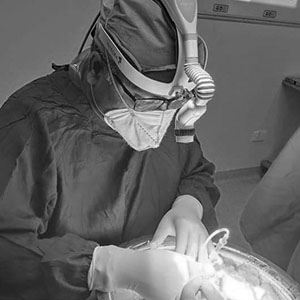Overview:
- Dialysis is a common treatment for people whose kidneys are not functioning. Taking over the work of the failing kidneys, a dialysis machine filters out toxins from the blood in people who have end-stage renal/ kidney disease.
- To undergo dialysis, a patient must first have a surgical procedure to create an access point for the machine. This is typically done in the arm or the wrist, most often by connecting an artery and a vein. The procedure is performed by a surgeon who specializes in this.
- Once the diagnosis of end-stage renal disease is reached, the option of dialysis should be discussed. For this patient need to have proper access. The longest-lasting and best type of dialysis access is an arteriovenous fistula, or AV fistula.
What is an A V Fistula?
- An AV fistula is a connection that’s made between an artery and a vein for dialysis access. A surgical procedure, done in the operating room, is required to stitch together two vessels to create an AV fistula. The access point must be durable enough to withstand dialysis two to three times a week without collapsing.
- Most commonly fistula is created at the level of wrist, called as radiocephalic AV Fistula. It is achieved when the surgeon connects the radial artery and the cephalic vein in the patient’s wrist. Second most common location is in arm. It is achieved when the surgeon connects the brachial artery and the cephalic vein in the patient’s arm and called as brachiocephalic AV Fistula.
- There are other surgical configurations as well, usually created in a patient’s forearm. If you undergo this procedure, the surgeon will work with you to choose the best option for you.
- AV fistula surgery takes a few hours and is generally an outpatient procedure. It can be done under general anaesthesia/ brachial block or local anaesthesia, which will be decided by operating surgeon.
When does AV fistula surgery take place?
- The surgery is performed approximately six months before the first session of dialysis. It can take several weeks (usually 4 to 6 weeks) for the AV fistula to heal and become sturdy enough to withstand the high blood flow while on dialysis treatment. Over the weeks following surgery, the high-pressure blood flow from the artery stretches the walls of the vein. As the vein stretches, it enlarges. The result in a long-lasting access point that allows the dialysis technician to easily connect the patient to the dialysis machine.
- Before Surgery the surgeon can ask you to get Upper Limb Ultrasound Doppler study to know the status and vessels including vein and artery and decide the best location of fistula.
How is an AV fistula used during dialysis?
- An AV fistula is how patients are connected to a dialysis machine. A dialysis technician starts your dialysis treatment by inserting two needles into the AV fistula. One needle removes the blood and sends it to the machine, where it is filtered. The second needle allows the blood to be safely returned to the body. Each dialysis treatment takes three to four hours, and generally patients need three treatments a week.
Are there alternatives to AV fistula?
- AV fistula is the best way to receive dialysis because it’s a long term solution for dialysis patients and carries a low risk of infection. However, there are several alternatives worth considering. If you do not have a vein of sufficient size for an AV fistula, an artificial vein may be installed via AV bypass graft surgery.
- If immediate dialysis is required, a temporary dialysis catheter can be inserted in a neck or thigh vein until a longer-term solution is created.
- In case of multiple failed attempts sometimes your doctors prefers to insert a long term dialysis catheter called as Permacath.
- Your treating team would help you finding the best dialysis access option for you.
Precautions after AV Fistula surgery
Do’s
- Keep the surgery arm slightly elevated with 1-2 pillows.
- In case of Brachiocephalic fistula Keep the elbow straight. After 2-3 days you can bend the elbow.
- Do not lift weights with the surgery arm.
- Do not keep the arm hanging down – this can increase the swelling.
- Take all the prescribed medicines regularly.
- Change the dressing after two days. After that keep changing the dressing after leaving a day, keep the bandage dry.
- You can take a shower every time you change your bandage.
- It takes 4-6 weeks for the AV fistula to be ready for dialysis after surgery. So start dialysis from the fistula only after showing it to the surgeon.
- In AV fistula, check daily for “Thrill/ Bruit – the feel/sound of blood flowing rapidly”.
- Pay attention to redness or swelling around the fistula.
Dont’s
- No one should be allowed to inject or draw blood for examination in the hand with fistula.
- Do not inject a needle into the fistula for anything other than dialysis.
- Do not check blood pressure in the hand with fistula.
- Do not sleep on the side of the hand with fistula.
- Do not lift too much weight with the hand with the fistula.
- Do not wear a watch or tight clothing in the hand with fistula.
If you have any of these problems, meet operating team immediately
- Frequent bleeding
- Excessive swelling
- Gradual increase in swelling in the hand with the fistula
- Thrill present or absent
- If the skin is red, swollen or pus appears at the site of the fistula puncture.
- There is pain in the fingers of the hand in front of the fistula, or the colour of the fingers is black.
- Enlarged veins appear on the face, arms, or chest
- During dialysis, the vein pressure is increased, or the flow in the fistula is reduced.
- It took longer for the bleeding to stop after the dialysis needle was removed.
Get An Expert Consultation
* Kidney Transplant
* Robotic Kidney Transplant
* SWAP Kidney Transplant
* ABO Incompatible Transplant
* AV Fistula
* CAPD Cather Insertion
drvarunmittal@yahoo.com

